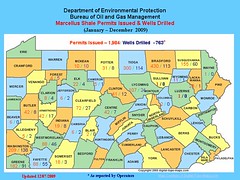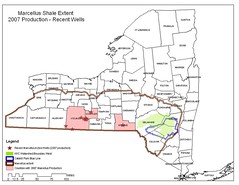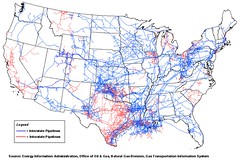Sat., February 13, 2010
Local Commentary
NORTHEASTERN Pennsylvania once contained three-quarters of the Earth’s anthracite coal deposits and, at the turn of the 19th century, provided the United States with the fuel it needed for consumer heating and industrial production.
But the hard coal industry also violated a once beautiful region rich in evergreens and oaks, leaving black refuse piles. It polluted springs and creeks, leaving acidic waste and the stench of sulfur. Underground fires, cave-ins and mine subsidence haunted many local towns for generations.
Today, the region’s natural resources again are being exploited for financial profit. Companies contend that deposits trapped miles below the Earth’s surface hold enough natural gas to supply the entire United States for 15 years. Although these companies insist there is little risk to the environment, there is serious cause for concern.
The Marcellus shale is a low-density, carbon bedrock that lies a mile or more beneath the surface in Pennsylvania, New York, West Virginia and Ohio. The shale contains an enormous volume of potentially recoverable gas, which has great economic significance for the United States at a time when we are seeking alternative fuel sources.
Gas is extracted from the Marcellus shale through a process called “hydraulic fracturing,” or “fracking,” in which up to 4 million gallons of water mixed with sand and chemicals is pumped into the shale at high pressure. The drilling not only breaks apart the shale to release the gas, but also discharges hazardous substances.
Gas companies claim that there is little risk, insisting that fracking is used safely in most oil and gas drilling operations. But last September, the Pennsylvania Department of Environmental Protection (DEP) reported that an estimated 8,000 gallons of fracking fluid spilled into a creek near Dimock, Susquehanna County. The spill was blamed on “faulty pipe work” and resulted in a significant fish kill.
Two months later, on Nov. 20, Reuters News Service reported that several of Dimock’s residents sued Cabot Oil & Gas Corp., claiming its natural gas drilling had contaminated their water wells with toxic chemicals, caused gastrointestinal sickness and reduced their property values. The lawsuit accuses Cabot of negligence and says it has failed to restore residential water supplies disrupted by gas drilling.
Dimock is not an isolated case. Hydraulic fracturing is the suspected source of impaired or polluted drinking water reported by residents who had gas drilling near their homes in southwest Pennsylvania and West Virginia.
Despite the apparent risk, the state DEP continues to issue hundreds of Marcellus drilling permits and the current state budget requires the Department of Conservation and Natural Resources to raise $60 million by leasing up to 10,000 more acres of public forestland to drillers within the year.
Gas companies are offering more than $1,000 per acre to some residents whose property overlays the Marcellus shale in order to continue the drilling. And they are protected legally for any liability.
In 2005, Congress, at the urging of then Vice President Dick Cheney, passed the “Halliburton loophole” to the Safe Drinking Water Act. The measure prevents the U.S. Environmental Protection Agency from regulating the fracking process. Halliburton, which was previously headed by Cheney, reportedly earns $1.5 billion a year from its energy operations, which rely substantially on the hydraulic fracturing business.
Pennsylvania cannot allow financial profits to take precedent over environmental stewardship. Harrisburg can begin immediately by calling for a moratorium on gas drilling in the Marcellus shale until a detailed scientific study is completed on the fracking process.
In the meantime, we should demand that our state representatives establish legislation that creates buffer zones for drilling near water supplies, requires gas companies to disclose the chemicals used in the fracking process and establishes strict guidelines for those companies to clean up the hazards created by their drilling.
LINK


















No comments:
Post a Comment